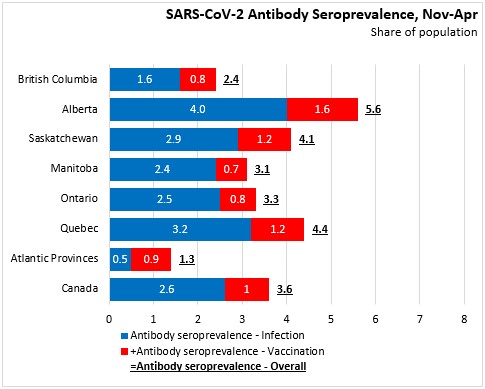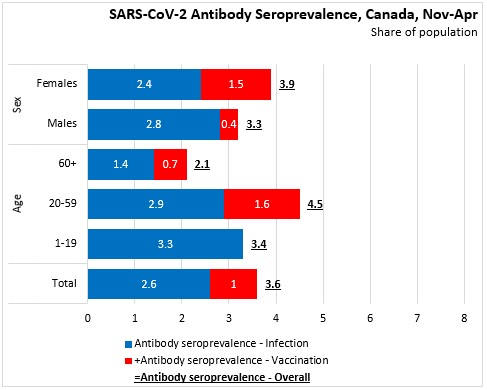The Economics and Statistics Division maintains archives of previous publications for accountability purposes, but makes no updates to keep these documents current with the latest data revisions from Statistics Canada. As a result, information in older documents may not be accurate. Please exercise caution when referring to older documents. For the latest information and historical data, please contact the individual listed to the right.
<--- Return to Archive
For additional information relating to this article, please contact:
July 19, 2021CANADIAN COVID-19 ANTIBODY AND HEALTH SURVEY (NOV-APR) Statistics Canada recently published the results of a study conducted with Canada's COVID-19 Immunity Task Force, the Public Health Agency of Canada and Health Canada. This study used blood tests from a sample of Canadians to determine the proportion of the population with SARS-CoV-2 antibodies ("seroprevalence"). These data were conducted between November 2020 and April 2021, prior to widespread vaccination among the population.
Using the results of laboratory tests and questionnaires, Statistics Canada reports that 3.6% of the population had antibodies from either a previous infection or vaccination. Past infections accounted for antibodies in 2.6% of the population while vaccination accounted for 1%.
Across Canada, the highest seroprevalence was reported in the Territories (21.1%), which was all attributed to vaccination as seroprevalence from prior infections was to low to obtain a reliable estimate. Seroprevalence from past infections was highest in Alberta (4.0%) and Quebec (3.2%). Seroprevalence from prior infection was lowest in Atlantic Canada at 0.5% (the four Atlantic provinces had to be grouped to obtain reliable estimates). In Atlantic Canada, seroprevalence was higher from vaccination than from prior infection.

Across the country, seroprevalence from infections was slightly higher among males than among females. However, vaccination-based seroprevalence was higher among females, who were disproportionately represented in the early stages of vaccination rollout. Overall seroprevalence was higher among females due to earlier-stage vaccinations. Among age cohorts, seroprevlance from infection was highest among those aged 1-19, followed by those aged 20-59. Those aged 60 and older had lower seroprevalence from prior infection. At the early stage of vaccination rollout (which often targeted health care workers), seroprevalence from vaccination was higher among those aged 20-59.

Note: there was insufficient vaccination-based seroprevalence for those aged 1-19 to report an estimate for this time period.
Source: Statistics Canada. Table 13-10-0818-01 SARS-CoV-2 antibody seroprevalence in Canadians, by age group and sex, November 2020 to April 2021
<--- Return to Archive